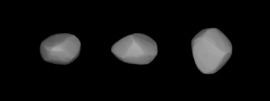Discovered by C. H. F. Peters Alternative names A899 LA; A899 UA Aphelion 473.341 Gm (3.164 AU) Discovered 19 September 1865 Spectral type C-type asteroid Asteroid family Eunomia family | Discovery date September 19, 1865 Minor planet category Main belt Perihelion 320.334 Gm (2.141 AU) Orbits Sun Named after Io | |
 | ||
Discoverer Christian Heinrich Friedrich Peters Similar Christian Heinrich Friedrich Peters discoveries, Other celestial objects | ||
85 Io (/ˈaɪ.oʊ/ EYE-oh) is a large, dark main-belt asteroid of the C spectral class. It is probably a primitive body composed of carbonates. Like 70 Panopaea it orbits within the Eunomia asteroid family but it is not related to the shattered parent body.
Io is a retrograde rotator, with its pole pointing towards one of ecliptic coordinates (β, λ) = (-45°, 105°) or (-15°, 295°) with a 10° uncertainty. This gives an axial tilt of about 125° or 115°, respectively. Its shape is quite regular.
It was discovered by C. H. F. Peters on September 19, 1865, and named after Io, a lover of Zeus in Greek mythology.
An Ionian diameter of 178 kilometres was measured from an occultation of a star on December 10, 1995. Another asteroid occultation of Io (magnitude 13.2) occurred on March 12, 2009, from the eastern USA, with the star 2UCAC 35694429 (magnitude 13.8).
Io is also the name of the volcanic satellite of Jupiter. With a two-digit number and a two-letter name, 85 Io has the shortest designation of all minor planets.
